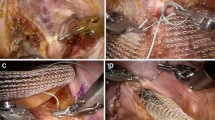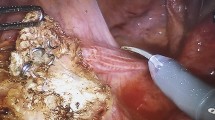Abstract
Background
Laparoscopic ventral rectopexy has been used to treat male patients with external rectal prolapse, but evidence to support this approach is scarce. The aim of this study was to evaluate the results of this new abdominal rectopexy surgical technique in men.
Methods
This was a retrospective multicenter study. Adult male patients who were operated on for external rectal prolapse using ventral rectopexy in five tertiary hospitals in Finland between 2006 and 2014 were included in the study. Patient demographics, detailed operative, postoperative and short-term follow-up data were collected from patient registers in participating hospitals. A questionnaire and informed consent form was sent to all patients. The questionnaire included scores for anal incontinence, obstructed defecation syndrome, urinary symptoms and sexual dysfunction. The main outcome measure was the incidence of recurrent rectal prolapse. Surgical morbidity, the need for surgical repair due to recurrent symptoms and functional outcomes were secondary outcome measures.
Results
A total of 52 adult male patients with symptoms caused by external rectal prolapse underwent ventral rectopexy. The questionnaire response rate was 64.4 %. Baseline clinical characteristics and perioperative results were similar in the responder and non-responder groups. A total of 9 (17.3 %) patients faced complications. There were two (3.8 %) serious surgical complications during the 30-day period after surgery that necessitated reoperation. None of the complications were mesh related. Recurrence of the prolapse was noticed in nine patients (17 %), and postoperative mucosal anal prolapse symptoms persisted in 11 patients (21 %). As a result, the reoperation rate was high. Altogether, 17 patients (33 %) underwent reoperation during the follow-up period due to postoperative complications or recurrent rectal or mucosal prolapse. According to the postoperative questionnaire data, patients under 40 had good functional results in terms of anal continence, defecation, urinary functions and sexual activity.
Conclusions
Laparoscopic ventral rectopexy is a safe surgical procedure in male patients with external prolapse. However, a high overall reoperation rate was noticed due to recurrent rectal and residual mucosal prolapse. This suggests that the ventral rectopexy technique should be modified or combined with other abdominal or perineal methods when treating male rectal prolapse patients.
Similar content being viewed by others
References
Lundby L, Laurberg S (2014) Laparoscopic ventral rectopexy for obstructed defecation syndrome: time for a critical appraisal. Colorectal Dis 17:102–103
Kairaluoma MV, Kellokumpu IH (2005) Epidemiologic aspects of complete rectal prolapse. Scand J Surg 94:207–210
Senapati A, Gray RG, Middleton LJ et al (2013) PROSPER: a randomized comparison of surgical treatments for rectal prolapse. Colorectal Dis 15:858–870
Samaranayake CB, Luo C, Plank AW, Merrie AE, Plank LD, Bissett IP (2010) Systematic review on ventral rectopexy for rectal prolapse and intussusception. Colorectal Dis 12:504–512
Faucheron JL, Trilling B, Girard E, Sage PY, Barbois S, Reche F (2015) Anterior rectopexy for full-thickness rectal prolapse. Technical and functional results. World J Gastroenterol 21:5049–5055
D’Hoore A, Cadoni R, Penninckx F (2004) Long-term outcome of laparoscopic ventral rectopexy for total rectal prolapse. Br J Surg 91:1500–1505
Randall J, Smyth E, McCarthy K, Dixon AR (2014) Outcome of laparoscopic ventral mesh rectopexy for external rectal prolapse. Colorectal Dis 16:914–919
Consten EC, van Iersel JJ, Verheijen PM, Broeders IA, Wolthuis AM, D’Hoore A (2015) Long-term outcome after laparoscopic ventral mesh rectopexy: an observational study of 919 consecutive patients. Ann Surg 262:742–747
Gosselink MP, Joshi H, Adusumilli S et al (2015) Laparoscopic ventral rectopexy for faecal incontinence: equivalent benefit is seen in internal and external rectal prolapse. J Gastrointest Surg 19:558–563
Slawik S, Soulsby R, Carter H, Payne H, Dixon AR (2008) Laparoscopic ventral rectopexy, posterior colporrhaphy and vaginal sacrocolpopexy for the treatment of recto-genital prolapse and mechanical outlet obstruction. Colorectal Dis 10:138–143
Owais AE, Sumrien H, Mabey K, McCarthy K, Greenslade GL, Dixon AR (2014) Laparoscopic ventral mesh rectopexy in male patients with internal or external rectal prolapse. Colorectal Dis 16:995–1000
Mercer-Jones MA, D’Hoore A, Dixon AR et al (2014) Consensus on ventral rectopexy: report of a panel of experts. Colorectal Dis 16:82–88
Jorge JMN, Wexner SD (1993) Etiology and management of fecal incontinence. Dis Colon Rectum 36:77–97
Altomare DF, Spazzafumo L, Rinaldi M, Dodi G, Ghiselli R, Piloni V (2009) Set-up and statistical validation of a new scoring system for obstructed defecation syndrome. Dis Colon Rectum 52:592–597
Cappelleri JC, Rosen RC, Smith MD, Mishra A, Osterloh IH (1999) Diagnostic evaluation of the erectile function domain of the International Index of Erectile Function. Urology 54:346–351
Barry MJ, Fowler FJ Jr, O’Leary MP et al (1992) The American Urological Association symptom index for benign prostatic hyperplasia. The Measurement Committee of the American Urological Association. J Urol 148:1549–1557
Irwin DE, Milsom I, Kopp Z, Abrams P, Artibani W, Herschorn S (2009) Prevalence, severity, and symptom bother of lower urinary tract symptoms among men in the EPIC study: impact of overactive bladder. Eur Urol 56:14–20
Author information
Authors and Affiliations
Corresponding author
Ethics declarations
Conflict of interest
The authors declare that they have no conflict of interest.
Ethical approval
The local ethics council of Oulu University Hospital (Oulu, Finland) approved the present study, which was conducted according to the Declaration of Helsinki.
Informed consent
Written consent from the patients was not obtained, but the volunteers responding to the original survey was considered as consent to participate in the present study. The National Institute for Health and Welfare (Helsinki, Finland), approved the present study and the use of registry data following local ethical approval, according to the Finnish law.
Rights and permissions
About this article
Cite this article
Rautio, T., Mäkelä-Kaikkonen, J., Vaarala, M. et al. Laparoscopic ventral rectopexy in male patients with external rectal prolapse is associated with a high reoperation rate. Tech Coloproctol 20, 715–720 (2016). https://doi.org/10.1007/s10151-016-1528-1
Received:
Accepted:
Published:
Issue Date:
DOI: https://doi.org/10.1007/s10151-016-1528-1




